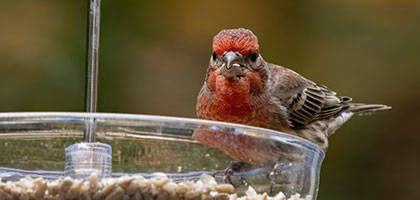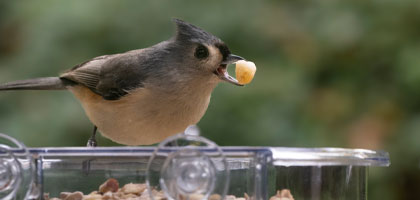Feeding cardinals in your garden can be a rewarding experience. It's a chance to observe these beautiful birds up close.
However, attracting cardinals and keeping them healthy requires knowledge. You need to understand their feeding habits and preferences.
This guide will provide you with the best practices for feeding cardinals in your garden. It covers everything from choosing the right bird food to selecting suitable feeders.
We'll also discuss how to protect your feathered visitors from predators. Plus, we'll share tips on how to make your garden more cardinal-friendly.
Whether you're a birdwatching enthusiast or a homeowner looking to create a bird-friendly garden, this guide is for you.
So, let's dive in and learn how to attract, feed, and care for cardinals in your garden.
Understanding Cardinal Preferences
Cardinals are particular about their food preferences, which is crucial for attracting them. They love seeds that are rich in oil content and offer ample nutrition.
Here are some cardinal-friendly bird food options:
- Sunflower hearts
- Safflower seeds
- Cracked corn
- Nyjer seeds
Offering a variety of these foods ensures cardinals get the nutrition they need. It's also beneficial to mix different seeds to cater to other bird species visiting your garden. Cardinals often share feeding spaces with species like finches, which also enjoy seeds and mixes.
Choosing the Right Feeders for Cardinals
Selecting the proper feeder is essential for ensuring easy access to food for cardinals. Cardinals prefer feeders that allow them to perch comfortably while enjoying their meals.
There are several feeder types suitable for cardinals:
- Large bird feeder: Offers ample space for multiple birds.
- Platform or tray feeder: Provides a flat surface for easy feeding.
- Hopper feeder: Protects seeds from weather while giving cardinals space to perch.
While choosing feeders, consider the size and design. Cardinals need stable feeders that they can grip easily, so avoid small bird feeders that may be too cramped. Equipping your garden with various feeders can increase cardinal visits and may draw in other birds, such as bluejays and bluebirds. A window feeder might also be appealing if you enjoy watching cardinals feed up close.
Placement and Protection of Feeders
Proper placement of feeders is key in attracting cardinals while keeping them safe. Choose spots that offer natural protection from wind and rain. Positioning feeders near shrubs or trees can provide cardinals with quick shelter if a predator approaches.
Safety from predators like squirrels and raccoons is also important. Using a squirrel proof feeder can help deter these intruders from stealing bird food. Hanging feeders at a safe height and adding baffles can further protect cardinals. Consistently monitoring feeder conditions will ensure a welcoming environment for these beautiful birds.
The Best Bird Food to Attract Cardinals
Cardinals thrive on a variety of bird food that provides essential nutrients. Their beaks are perfect for cracking open seeds, making certain types especially appealing. Offering a diverse selection of bird seed will also invite other lovely species, enhancing your garden's bird population.
Here is a list of cardinal favorites:
- Sunflower Hearts and Seeds: Cardinals adore these for their rich energy content.
- Safflower Seeds: Less attractive to squirrels, these seeds are perfect for feeding cardinals.
- Cracked Corn: A budget-friendly option that brings cardinals flocking.
Beyond seeds, try supplementing their diet with nuts like peanuts to offer a protein boost. Nuts can be served whole or crushed and placed in a peanut feeder for easy access. Incorporating fresh fruit into your bird feeding routine is another way to delight cardinals. Chopped apples or berries can attract not only cardinals but also orioles and bluebirds.
Seasonal Feeding Tips for Cardinals
Seasons change, and so do the feeding habits of cardinals. During winter, provide high-energy foods like suet pellets, cakes, and balls. These options help cardinals maintain their energy levels in colder months. As temperatures drop, ensuring your bird feeders are stocked with these nutritious choices can be vital.
In spring and summer, cardinals may need extra protein for breeding and raising chicks. Mealworms are an excellent protein source during these seasons. Additionally, offering fresh fruit during warmer months can keep cardinals healthy and satisfied. Adjusting your bird feeding routine with these seasonal tips will support cardinals all year round.
Preventing Squirrels and Raccoons from Raiding Feeders
Squirrels and raccoons can quickly deplete your bird food supplies. To protect your bird feeders, consider using squirrel proof feeders. These feeders are designed to deter these persistent animals with weight-sensitive mechanisms or enclosures.
Position feeders out of reach and away from tree branches to limit easy access. Adding baffles can also block squirrels from climbing up poles or trees. Consistently monitoring and adjusting feeder placements will help ensure your food is primarily enjoyed by cardinals and not local wildlife intruders. These prevention techniques can safeguard your bird feeding efforts and maintain peace in your garden.
Additional Ways to Attract Cardinals
Creating a welcoming environment will encourage cardinals to frequent your garden. Cardinals are drawn to spaces that offer ample food, water, and shelter options. By incorporating these elements, you can build a sanctuary for these vibrant birds.
Consider these additional features to attract cardinals:
- Provide clean, fresh water in a birdbath for drinking and bathing.
- Plant native shrubs and trees to offer natural food and cover.
- Include berry-producing plants like dogwood and elderberry for added nutrition.
By combining these strategies, you can cultivate a bird-friendly habitat that attracts cardinals year-round. This balanced approach supports not only cardinals but also enhances the natural beauty of your garden.
Maintaining a Healthy Feeding Environment
To ensure cardinals remain healthy, keeping feeders clean is crucial. Dirty feeders can harbor mold and bacteria that are harmful to birds. Regularly clean your bird feeders with mild soap and water, then rinse thoroughly. This practice prevents disease spread and attracts more cardinals to safe, appealing feeding stations.
Ethical feeding practices extend beyond cleanliness. Providing a variety of natural and nutritious food helps meet cardinals' dietary needs. Also, monitor the food for signs of spoilage and replace it as needed. By maintaining a clean and balanced feeding environment, you promote the well-being of cardinals in your garden.
Engaging the Community in Cardinal Conservation
Encouraging your neighborhood to adopt bird-friendly practices can significantly impact cardinal populations. Share information on planting native shrubs and using safe bird-feeding methods. Organize community events focused on cardinal conservation to foster a collective effort. Together, you can create a vibrant habitat that supports and nurtures local wildlife.
Conclusion: The Joy of Feeding Cardinals
Feeding cardinals in your garden brings joy and a deeper connection with nature. By following best practices, you provide these beautiful birds with nourishment and safety. Enjoy watching your garden flourish with vibrant cardinals, knowing you support their health and well-being while enriching your outdoor experience.






